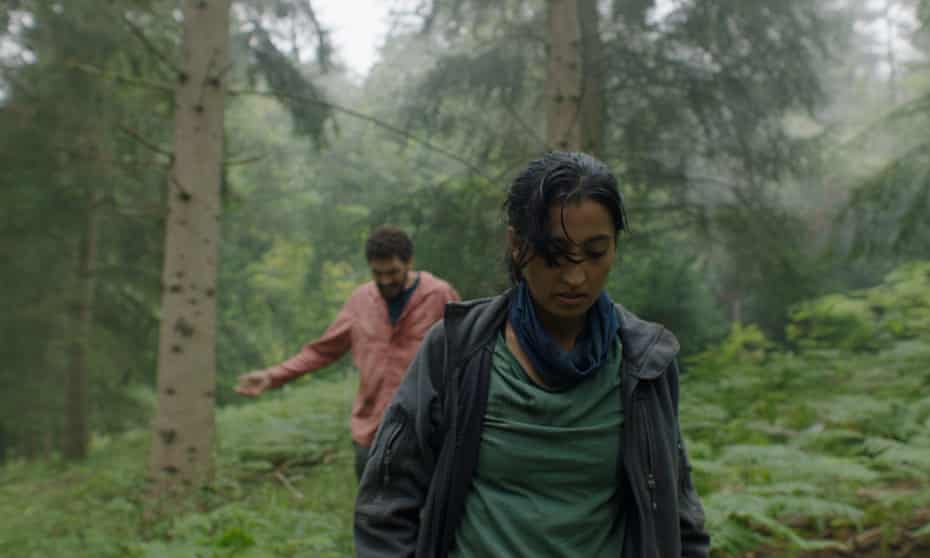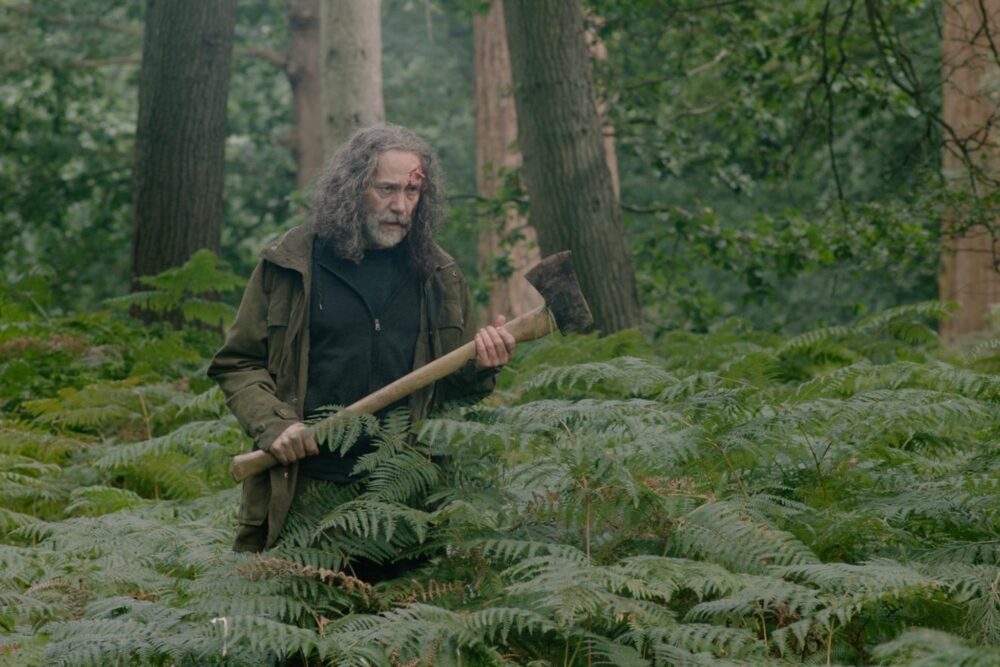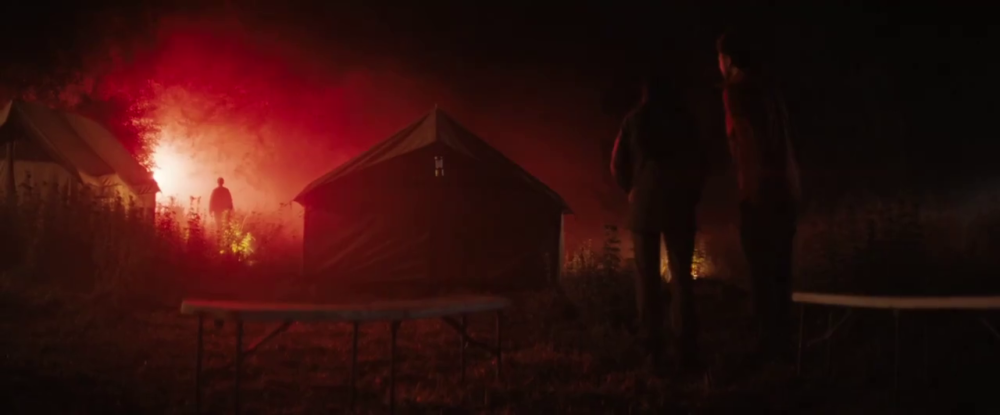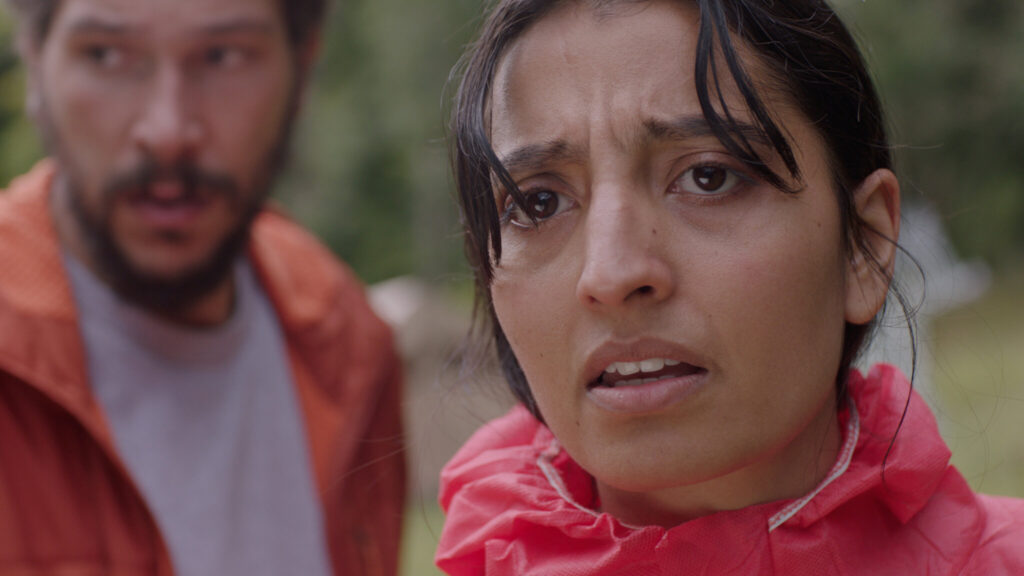After a quick shot of a standing stone somewhere in a forest, an unknown person smashes a rock into smithereens using a powerful tool. They then plant a shard from those smaller pieces in the ground (or in the earth, if you will). Whether as treasure or trap we don’t know what that piece is for; all we know is that Nick Gillespie’s lush cinematography and Clint Mansell‘s haunting score that accompany the scene are giveaways that it’s not a good look.
Quite an atmospheric and ominous way for Ben Wheatley’s “In the Earth” to begin.
We then see a man going to the woods. He stops on his tracks when he sees a few signs that read:
Stop the Spread of Germs
Safety First
Please Wear a Mask
His destination, a vacation lodge, is now leased to the government to be used as scientific and research base. Along with the signs, we see safety measures, lockdowns, masks, and sanitizers. In Wheatley’s latest film, today’s reality gets another depiction on screen—this time as a horror film.
The man, Martin Lowery (Joel Fry), goes there to continue the research of a colleague, Olivia Wendle. That research involves making crops more efficient through the study of mycorrhizal; with the land of the forest being unusually fertile and appropriate to do the research on. Wendle, who used to lead the research, had gone missing for months, so Martin decides to come not only to continue the research but also find her whereabouts.

When Science and the Occult Collide, Paranoia Ensues
As Martin prepares to go to the research site, the doctor who examined him warns about the dangers of the woods, and how the previous team who went there got lost and didn’t make it out.
“Doesn’t look hostile to me,” he simply mutters. For Martin, that—along with his park guide Alma’s (Ellora Torchia) story about Parnag Fegg, the spirit of the woods according to the local folktale—is just something not to be taken seriously.
But when he learns from Alma that the site is a two-day walk from the lodge (and the ensuing trek they’d embark on), Martin senses the air of unrest kick in. And as they trudge on deeper into the woods, Alma remarks about his uneasiness. A penny for his thoughts, Martin responds, “It’s just odd, being outside for the first time in months.” Alma, on the other hand, expresses optimism that things would get back to normal quicker than he thinks.
It’s an exchange we’ve come to hear too often in today’s pandemic-stricken world.
That unrest, however, quickly gives way to fear when they find traces of human activity but no other soul. And after an ambush as they were asleep one night, the two meet another man in the woods by chance the morning after. The man, Zach (Reece Shearsmith), offers help which they both accept.
However, oftentimes with horror films, trusting no one appears to be the wisest decision.

“In the Earth”: Another Entry to the Pandemic Filmography
“In the Earth” is evidently another entry to the ‘COVID-19 Filmography’; a list of movies that either integrate the pandemic into their narrative, or allude to it by using the merits of a specific genre. In the case of Wheatley’s film, “In the Earth” makes use of horror in all channels to bring out the worst in humanity; which happens during moments in history when either chaos or survival are in play—sometimes both at the same time.
Elements of the film look and sound all too familiar. For instance, the movie establishes right away that normalcy in its world is a rarity (“Bristol took a bad hit after the third wave”). That’s enough subtext about a world dropping on its knees amid a global pandemic.
As a pandemic film, “In the Earth” manages to be insightful and gripping, even if at times it slips due to its overindulgence with style. On surface, one can chalk it up to Wheatley’s process; after all, he has stated that the film took only 15 days to write and direct. If anything, those uneven and frustrating narrative choices are his doing.
An Insightful—Although Somewhat Uneven—Meditation on Human Fears
Nevertheless, in its part, “In the Earth” uses the conventions of horror films with a sense of dread, while using science as backdrop to give its characters the motivation to keep on. Thus, many a time, the film reeks of the aftertaste of an unholy alchemy featuring science, fantasy, and horror.
Having that said; the loose narrative structure exacerbated by the tracking shots, the deep themes of pandemic paranoia bringing the worst of humanity—these are all textbook Ben Wheatley.
Complementing the director here are Nick Gillespie and Clint Mansell. The former’s blend of shaky camerawork and long-tracking shots infuse the film with a sense of urgency and verisimilitude. These techniques amplify the paranoia and dial it to eleven. Finally, Mansell’s haunting score adds layers to the kaleidoscope of unrest the film subjects the audiences to right off the bat—and never lets up.

Interesting Addition to Ben Wheatley’s Diverse Filmography
Which brings me to the final point: as I recount Wheatley’s films, all of which I have already watched, I realized that “In the Earth” is just pure Ben Wheatley. Here’s what I mean: the film is emblematic of the filmmaker’s streak: When he struggles, he struggles really bad (i.e. “Rebecca”). But when he’s on, he’s really on (“Happy New Year, Colin Burstead”).
Sometimes, though, even his films not receiving as much critical acclaim (e.g. “High-Rise”) are packed with ideas and themes that trump other better-received contemporaries. This can be a pitfall, too, given how much Wheatley loves to test his audience’s patience (our colleague even gave Wheatley’s film “A Field in England” a grade of ‘D’ for this very reason).
Suffice to say, the director’s films are an acquired taste; but once the audience sees through the weirdness of it all, they can find a great film underneath just waiting to be explored. Fortunately, despite using the same approach, “In the Earth” teeters closer to his better films. Personally, I think this is arguably his most interesting since “Free Fire.”
In the end, “In the Earth” sees director Ben Wheatley on a regular Tuesday: contextualizing raw and jagged but incisive ideas in a niche genre. What comes out of it is a timely film, albeit too slow-burning for its own good. Nonetheless, Wheatley manages to blend science fantasy and horror to explore the paranoia and chaos in a pandemic-ravaged world.


